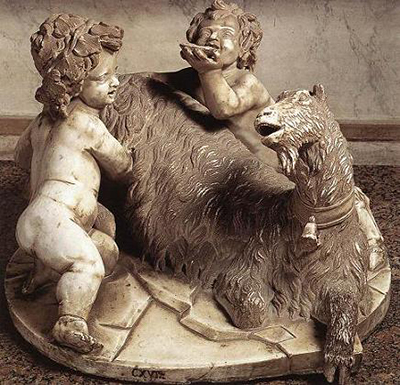Bernini's statue of the goat Amalthea with the infant Jupiter and a faun is of particular significance, since it is believed to be the earliest identified work of this supreme sculptor of the Baroque style.
While the date of the statue is not certain, an invoice received for work done on the wooden pedestal means it certainly predates 1615.
It is a remarkably mature piece for an artist who was in his teens or even younger. The theme is ultimately drawn from Greek myth relating to Zeus, who was hidden on Crete to avoid the predations of his father Cronus. Cronus had overthrown his own father, Uranus, in bloody rebellion, and it was prophesied that he would in turn be slain by his own sons. To overcome the prophesy, Cronus ate all his children the instant they were born. In order to protect Zeus, Rhea, his mother, not only tricked Cronus but hid her son in a cave on Crete, where he was protected by the nymphs and the wild Korybantes, worshippers of the goddess Cybele. Here, the goat Amalthea nursed and guarded the young god as his surrogate mother.
Bernini's carrara marble statue transforms the myth to a Roman one. The two young boys, the god and the faun, are instantly recognisable as putti, the young naked children who sometimes appear as cherubs or cupids. Bernini may have created his first head of a putto, according to one biographer, as early as eight years old.
Created as one of a series of statues with pagan and mythological themes for Cardinal Scipione Borghese, in whose Villa Borghese it still stands, the statue reminds us how closely Rome's pagan past lay beneath its Christian surface. There is a naturalness to the statue as though there were nothing strange about having a goat for a mother. Amalthea - her name suggests a primeval goddess - has an oddly human expression, much like any mother who is tormented, amused and exasperated by her lively young toddlers.
The line between human and animal, mortal and divine, is blurred, a fact that is stressed by one of the participants in the scene being a faun, half human and half goat. In the future, the observer knows, the god Jupiter will appear to his human and divine lovers in the form of various animals, just as Zeus appeared to Europa as a bull, for instance. Often the encounters will be violent.
For now though, while he is a child, all the elements, human, animal and divine, at peace with each other in a state of equality, were it not for one detail, that of Amalthea's missing horn. The bell around her neck reminds us that she is domesticated and also a leader and protector - the bell scares off predators. Amalthea, nurturing yet fierce, is the central figure.
The young Jupiter had broken off the missing horn in his play. However, what might have been disastrous turns into a benefit for mankind. Amalthea's horn became the Cornucopia, the horn of plenty, while she was placed in the sky and given immortality as the constellation Capricorn.




